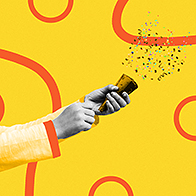Put the Start-Stop Technique to Use, Solo and Partnered, to Last Longer

Herbie Peterson, a young man diagnosed with a chronic illness, began experiencing premature ejaculation (PE) after his diagnosis. It was so severe that when Peterson (a pseudonym) went online to buy undergarments for his girlfriend, he came just from visiting the lingerie website.
Peterson's therapist, Jenn Bossio, Ph.D., a psychologist and owner of Tri Health Clinic in Kingston, Ontario, found he was experiencing a lot of stress-related to his chronic illness.
"That was really ramping up his nervous system, which was making ejaculation more likely to happen," Bossio said.
Bossio suggested Peterson try the start-stop method, a behavioral technique that involves stimulating the penis until right before ejaculation, then stopping. During penetrative sex, Peterson and his partner practiced stopping and not moving when he felt he was about to come.
"They'd have to wait quite a while, maybe up to a minute or even more, and then start pumping again," Bossio said.
After four therapy sessions with Bossio, and practicing the start-stop method with his partner, Peterson developed much better ejaculatory control. He also did some mindfulness work before using start-stop, which Bossio believes added to the technique's effectiveness.
"Start-stop worked super quickly with them," she said.
What is premature ejaculation?
Among the most common sexual disorders in men, PE may affect up to 39 percent of men, according to research. Premature ejaculation is often defined as when a climax occurs too quickly during sexual intercourse.
How quickly is "too quickly"?
"Porn will have you believe that men should last for 30 to 40 minutes," Bossio said. "In reality, around that five-minute mark, give or take, tends to be entirely healthy. As sex therapists, we don't even bat an eye unless it's around the one-minute mark; that tends to qualify for premature ejaculation."
It's important to differentiate the men who are hardwired with this problem—the lifelong sufferers—versus men who develop it later in life, said Martin N. Kathrins, M.D., assistant professor of surgery at Harvard Medical School and a urologist at Brigham and Women's Hospital in Boston.
'Porn will have you believe that men should last for 30 to 40 minutes. In reality, around that five-minute mark, give or take, tends to be entirely healthy.'
"If a man has a time in mind that's not based on average physiology, it's important to frame his reference a little bit—not to tell him he doesn't have a problem but provide him with some epidemiology as to what is normal and what is average," Kathrins said. "That helps a lot of men understand their problem is not pathologic, and that's where the sexual therapists come in."
Kathrins occasionally recommends over-the-counter topical therapies or prescribes off-label antidepressants for men with PE, but said research data indicates the start-stop method can be effective.
A review in Therapeutic Advances in Urology found 45 percent to 65 percent of men with premature ejaculation report short-term benefits from the start-stop method. Research on long-term results, however, is limited.
Bossio said, anecdotally, she finds the start-stop method, in conjunction with mindfulness techniques and a focus on pleasure, is an effective technique for many of her therapy clients. We'll explain what is the start-stop technique in the next section.
What is the start-stop technique?
With the start-stop method, a man tries to keep his arousal below the orgasm threshold, or the "point of no return," when ejaculation is inevitable, according to Chelom Leavitt, Ph.D., assistant professor at the School of Family Life at Brigham Young University in Provo, Utah.
"The problem with a lot of men who are experiencing premature ejaculation is that that threshold is a little ambiguous," Leavitt said. "They're not quite sure when they're going to get there and, in fact, they were much closer than they thought and they orgasmed quicker than they wanted to. And so the start-stop technique helps slow that process down."
Generally, a man begins practicing the start-stop method alone during masturbation, according to Bossio, who recommends men find a safe-space environment. Once they begin masturbating and feel an increase in arousal leading up to the point of no return, they stop masturbating and let the arousal come back down before starting again.
The more men practice alone, the more familiar they will get with the physical sensation leading up to orgasm, Bossio said.
"Maybe they start to feel hot in parts of their body, maybe tension kicks up, their thoughts start to race, their breathing gets faster—all of these are physiological signs that I'm reaching that point of no return," she said.
Introducing a partner into the process could mean either the man pleasures himself or the partner pleasures him, Bossio said. When they engage in sexual intercourse, start-stop occurs when he feels he's getting close to orgasm and stays still as he waits for arousal to ease. Then he and his partner engage again and repeat the process as much as desired.
Kathrins said it's important for the partner to be supportive when a man is practicing start-stop.
"If he or she is denigrating the man, that's a setup for failure," he said. "That man needs emotional and psychological support. Mostly, there needs to be patience."
What are the shortcomings of the start-stop technique?
Typically, the drawbacks of the start-stop method are that it's very behavioral, procedural and doesn't involve paying attention to what's going on inside your head, according to Bossio.
"The idea of early ejaculation, it's thought of as he's enjoying himself too much, he's too excited, and it feels too good, and so he comes too quickly," Bossio said. "The reality is what's actually happening for the vast majority of these men, it's not that it feels too good, it's that they're too anxious."
The man's nervous system is so highly aroused that they ejaculate, she said, adding that it's important to distinguish ejaculation from orgasm. Ejaculation occurs when semen exits the penis, whereas orgasm is a brain-based event during which the man feels euphoric.
"The problem with the old-school technique for start-stop is it only looks at the physiological response of ejaculation," Bossio said. "It totally ignores the pleasure element and resulting orgasm element of it."
Leavitt agreed with Bossio that mindfulness techniques are a helpful tool in addition to start-stop. A vast majority of problems in sexuality are due to heightened anxiety, Leavitt said, and mindfulness can help alleviate the anxiety that's causing premature ejaculation.
"Too often, with some techniques, what we're doing is tamping down the intimacy that we might feel with our partner," Leavitt said. "In sexual mindfulness, we do the opposite. We actually want to focus on the intimacy that we feel with our partner, but do so in a way that isn't filled with anxiousness, so that we can connect with them and be vulnerable and communicate about whatever it is we're experiencing and not feel the heightened anxiety, which is often what propels men into premature ejaculation."




















